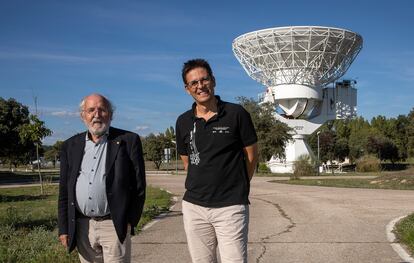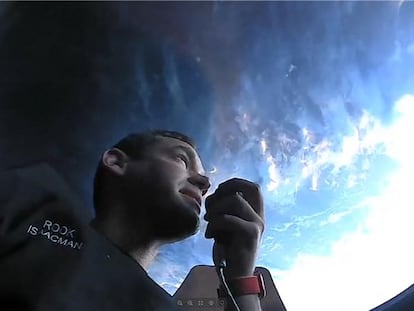The ‘impossible planet’ being observed by two Nobel laureates
Michel Mayor and Didier Queloz are studying 55 Cancri e, an exoplanet covered in an ocean of lava that is similar to Earth when it was first formed


For the past months, astronomers Michel Mayor, 78, and Didier Queloz, 55, have been observing an “impossible planet.” It’s called 55 Cancri e and it is a bit bigger than Earth. It’s so strange that it shouldn’t exist. But there it is: 40 light years from Earth, orbiting a twin star of the Sun. On this planet, a hemisphere is always facing the Sun. The surface is more than 2,000ºC, and the dark side is at 1,300ºC. It’s likely that the entire planet is covered in melted rock. It’s what the astronomers call a world of lava.
“This is the only planet of this type that we are able to observe,” Queloz tells EL PAÍS, while visiting Madrid alongside his mentor, Michel Mayor, to give a conference at the European Space Agency Centre (ESAC). The two Swiss astronomers won the Nobel Prize for Physics in 2019 for their 1995 discovery of the first planet outside the Solar System, which is known as an exoplanet. It was a giant gas planet orbiting star 51 Pegasi, 50 light years from Earth. Today – just 26 years after the discovery – more than 4,500 exoplanets have been identified. When the European space telescope CHEOPS was launched in 2019 with the aim of determining the size of known exoplanets, Queloz’s first goal was to study 55 Cancri e.
“We have infra-red observations of the thermal emissions of this planet,” explains Queloz. “What’s more, there is an observation in the visible light spectrum. This data does not give us a very clear idea of what the planet is like. We don’t know if it has an atmosphere nor if some part of its surface is solid. Nor do we know if there is a seasonal evolution. Why is it important then? Because it is not very different from what the newly born Earth was like, in its first 50 million years of life. It’s a little bigger, but it’s very similar. That’s why we need to understand it. The best thing is is that this planet is just in the right spot. With CHEOPS we are going to be able to study its evolution, its reflectivity. We can even determine if it has a permanent or temporary atmosphere. That’s why I’m so excited,” he says of 55 Cancri e, which was renamed Janssen in 2015, in honor of telescope pioneer Zacharias Janssen.
It’s tempting to imagine that in 4.5 billion years, the age of the Earth, there will still be humans following the developments of this world of lava.
The planet 55 Canri e is not very different from what the newly born Earth was like, in its first 50 million years of life. That’s why we need to understand itAstronomer Didier Queloz
Mayor explains that the other goal of exploring exoplanets is to find twin planets of Earth with other stars. “In our searches, we have found a lot of stars that could house the equivalent of our Solar System,” he says. “For a moment, let’s imagine that we are the aliens in another part of the universe and that we are looking at our own Solar System with the telescopes of today. If this were the case, right now we would only have discovered Jupiter and suspect that Saturn exists. We would have no idea about Earth,” he explains. Many of the exoplanets that have been discovered so far are big gas giants like Jupiter. It’s very likely that these planets are on the outskirts of solar systems that have rocky planets, like Earth, in the inner area. “But our technology is still too young to discover them,” says Mayor.
Queloz is leading an international project to discover new planets. The project is based on HARPS3, a new instrument specially designed to carry out the largest search for planets like Earth in solar systems with stars like the Sun. HARPS3 will be installed in the Newton telescope on La Palma, in Spain’s Canary Islands, which are located off the coast of northwestern Africa. This instrument takes the current technology to detect planets in other solar systems to the next level. Its mission is to achieve something that has never been done before. Stars like the Sun have an atmosphere and these emit light signals – noise – that can mask the presence of a rocky planet. “We have to kill this noise and we don’t know when we will be able to do this,” says Mayor.
HARPS3 will start operating in 2023 and will analyze 60 stars similar to the Sun. “My objective is that within 10 years, when I am retiring, this experiment will have ended,” says Queloz. “I am convinced that by then we will have discovered a twin of Earth. It’s possible that there are even 10. But we could have bad luck and the 10 are like Venus. I believe that Earth cannot be so strange, so unique.”
Hunting planets is just the first step. The astronomers will then need to determine if there is life on the planet. And that’s when things become very complicated. Current telescopes and those that will define the future of astronomical exploration in the next decades, such as the space telescope James Webb, can only detect signs of life – oxygen, water and other components of an atmosphere that could indicate the presence of a lifeform. “Even with the right equipment, we will never be sure of having detected life,” says Queloz. “A biologist is not going to believe you until there is a huge amount of evidence, they probably won’t accept it until you bring them the alien being alive.”
I am convinced that within 10 years, we will have discovered a twin of EarthAstronomer Didier Queloz
But reaching these worlds is impossible, says Mayor. “They are too far. Remember the journey to the Moon. We took three days to get there. Light makes the trip in a second. Imagine that we find a twin of Earth just 30 light years away. At this distance, it would be a very, very close neighbor. Light would take one billion seconds to get there. That is one billion times further than Apollo 11 [the spaceflight that first landed humans on the Moon] and that trip was the furthest humans have traveled on crewed missions. If you want to reach an exoplanet, you need to be able to make a rocket that approaches the speed of light and, more importantly, decelerates when it is near its destination. The energy needed is simply mammoth, impossible to reach.
The day after winning the Nobel prize, Mayor agreed to an interview with EL PAÍS, in which he said: “Religion says that God decided that there would only be life here, on Earth, and I believed it. Scientific facts show that life is a natural process. I believe that the only response is to investigate and find the answer, but for me, there is no place for God in the universe.” Mayor, however, recognizes that the technical limitations of human beings mean that it will be impossible to find out if there is life on an exoplanet for many centuries to come. But there is a shorter path, says Mayor: looking for life in areas of our own Solar System, in particular the frozen moons of Jupiter and Saturn. “It’s much more likely that we will be able to analyze and find extraterrestrial life in these places,” he says.
Tu suscripción se está usando en otro dispositivo
¿Quieres añadir otro usuario a tu suscripción?
Si continúas leyendo en este dispositivo, no se podrá leer en el otro.
FlechaTu suscripción se está usando en otro dispositivo y solo puedes acceder a EL PAÍS desde un dispositivo a la vez.
Si quieres compartir tu cuenta, cambia tu suscripción a la modalidad Premium, así podrás añadir otro usuario. Cada uno accederá con su propia cuenta de email, lo que os permitirá personalizar vuestra experiencia en EL PAÍS.
¿Tienes una suscripción de empresa? Accede aquí para contratar más cuentas.
En el caso de no saber quién está usando tu cuenta, te recomendamos cambiar tu contraseña aquí.
Si decides continuar compartiendo tu cuenta, este mensaje se mostrará en tu dispositivo y en el de la otra persona que está usando tu cuenta de forma indefinida, afectando a tu experiencia de lectura. Puedes consultar aquí los términos y condiciones de la suscripción digital.
More information
Archived In
Últimas noticias
Pablo Escobar’s hippos: A serious environmental problem, 40 years on
A floating school teaches children how to save Lake Atitlán
The brief rise and retreat of Generation Z in Mexico
From Andorra to Gibraltar, a black market for Ozempic exploits its success: ‘They’re the most sought-after products in the world’
Most viewed
- Why we lost the habit of sleeping in two segments and how that changed our sense of time
- Charles Dubouloz, mountaineering star, retires at 36 with a farewell tour inspired by Walter Bonatti
- Venezuela faces its most tense Christmas yet
- CBS in crisis after pulling a report on Trump’s deportations to El Salvador (which later leaked online)
- Bukele clan fumes over investigation exposing their new wealth










































